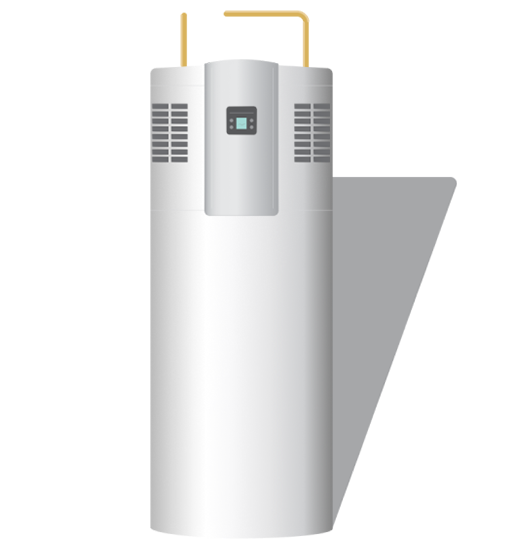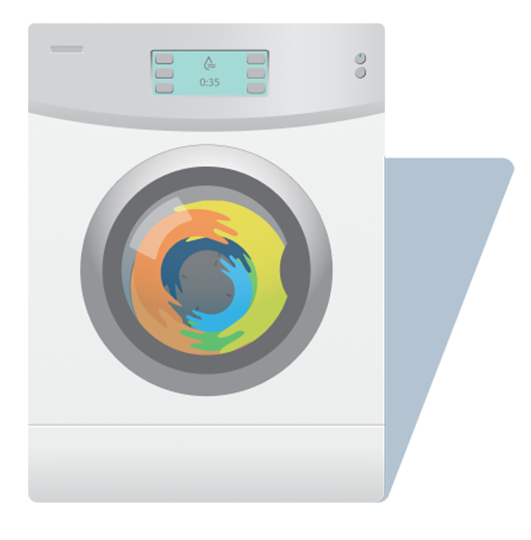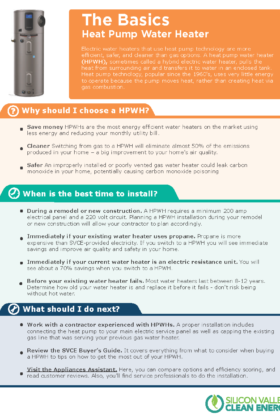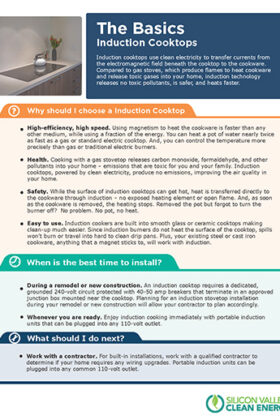SV Clean Energy customers can get $50 off yard care equipment and summer appliances .
Electric Appliances
at Home
Are you remodeling? Replacing old appliances? Make the switch to clean, all-electric and stop burning fossil fuels in your home. Healthier. Safer. More efficient. Learn more about why your home appliances matter, your options and how you and your community can benefit.

Why home appliances matter.
Did you know that nearly one-quarter of climate-changing pollution in Silicon Valley comes from natural gas used in our homes and buildings? Heating water and indoor air are main uses, but dryers, stoves and other appliances often use gas too. Switching to electric appliances and smart controls helps you use energy more efficiently, reduce pollution, and create a safer and more comfortable home environment. You’ll be glad you did! info

In most homes this is the largest user of energy and produces about 40% of a home’s harmful fossil fuel emissions. Save money and improve comfort with a smart thermostat and heat pump heating and cooling. Add to the benefits and eliminate emissions with an electric heat pump space heating and cooling system.

Most water heaters in Silicon Valley burn natural gas, producing nearly half of a home’s harmful fossil fuel emissions. Heat pump water heaters use clean electricity and actually cool the surrounding air. Learn about replacing your old gas water heater with a more efficient and safe choice.

Switching from gas to electric appliances eliminates toxic emissions in your home. Induction stoves are now favored by many top chefs for their speed, control, and safety. Electric clothes dryers are clean and safe. LED lighting, better insulation and home energy audits add comfort and savings.

Heat Pump Water Heater
Also called a hybrid electric water heater, these electric appliances are much more efficient than typical water heaters. Plus they use less energy by moving heat from surrounding air and transferring it to water in an enclosed tank. It’s designed to work with other services, like time-of-use electricity rates, and will save you money over the life of the appliance. Save even more with the SVCE FutureFit Homes Rebate Program.
Discover the next step to installing a heat pump water heater with The Basics and shop at the Appliances Assistant.
“SVCE’s FutureFit Rebate Program spurred me into action! We replaced our gas water heater with a heat pump water heater and reduced our gas usage and GHG emissions.”
 |

And there’s more!
Receive Rebates for Efficient Electric Home Upgrades
Get up to $8,750 in rebates for upgrading to new electric home appliances with our FutureFit Homes Program. Plus, additional rebates of up to $4,250 for income-qualified customers, including those enrolled in CARE/FERA.
Find a Contractor
Similar to other electric appliances, work with an experienced contractor. Some buildings will require an electrical panel upgrade prior to installation. Check out available resources to identify a contractor that can help you with installation here.
Want the Heat Pump Water Heater Cliff Notes? Read The Basics. Want more information? The Best Practices Guide covers a range of topics including what to consider when buying a heat pump water heater and factors to be aware of prior to installation. Interested in whole home electrification, check out the Building Practice Guide.

Heat Pump Space Heating & Cooling
One appliance that heats and cools? Move over, sliced bread. Heat pump space heating and cooling systems work by taking heat from surrounding areas and moving it to another location. In the summertime, it moves heat from inside your home to the outside and does the opposite in winter. Visit the SVCE FutureFit Homes Rebate Program for heat pump system rebates. Shop for cooling systems at the Appliances Assistant.
Learn more about this electric appliance with The Basics .

Induction Cooking
“As a pet owner we wanted the safest cooktop available, turns out it cooks faster too!”
 |
Using the power of magnets, induction cooking is increasingly being adopted as the preferred method of cooking. This impressive technology provides more accurate temperature control, an easy-to-clean surface, and heats water nearly twice as fast as gas or standard electric. And you’ll be cooking with clean electricity! Gas cooktops release harmful carbon monoxide, formaldehyde and other pollutants into your home. Learn more about this electric appliance with The Basics .
Get up to $750 on induction cooktops and cookware with the SVCE FutureFit Homes Rebate Program.

And there’s more!
Receive Rebates for Efficient Electric Home Upgrades
Get up to $8,750 in rebates for upgrading to new electric home appliances with our FutureFit Homes Program. Plus, additional rebates of up to $4,250 for income-qualified customers, including those enrolled in CARE/FERA.
Curious about the next steps to add an induction cooktop to your kitchen? Check out The Basics. Interested in learning more about why induction cooktops are top performers on consumer testing? Explore Consumer Reports for induction cooktops.
See what the community has to say too, and check out this article from the Los Altos Town Crier .
Plus, learn more about what professional chefs have to say about induction cooking and why they choose to cook with it. And for even more fun, see how induction cooktops only heat the pot or pan while the cooking surface remains cool in the video of an egg frying on a half pan on an induction cooktop.

Electric Dryer
When considering your home energy use, the dryer might not be the first appliance that comes to mind. But, the average American family washes approximately 300 loads of laundry every year and the energy use quickly adds up. Electric dryers are safer, cost less to purchase, and are simpler to install than gas dryers. Learn more about this electric appliance with The Basics .

Smart Thermostat
A smart thermostat is often the simplest and most cost-effective way to save money on your heating and cooling. It can learn your home and away patterns, control the temperature to your desired levels and comfort preferences, and automatically adjust to save you money when you’re not home. You can say you turned off the thermostat, even when you forgot. That’s why they call it smart! Learn more about this electric appliance with The Basics and shop at the Appliances Assistant.


Lighting & Other Efficiency Measures
When you switch from gas to all-electric appliances you reduce emissions and save money. Take one more step and minimize your energy usage. Install high-efficiency light bulbs and smart electronics, like thermostats and power strips. Learn more about energy-efficiency rebates and programs Save more money and save the planet with efficient, electric appliances.

Yard Care Equipment
When you upgrade your traditional gas-powered yard care equipment to electric, you are choosing a cleaner, more efficient solution. Electric leaf blowers, lawn mowers, trimmers, and chainsaws are as powerful as traditional gas-powered yard care equipment, plus they are quieter and emit zero emissions.
In addition to a better user experience, the emissions impact for gas-powered yard care equipment is significant. According to the California Air Resources Board , using a gas-powered lawn mower for one hour is equal to driving a gas car for 300 miles. Using a gas-powered leaf blower for one hour is equal to driving a gas car for 1,100 miles. Upgrade your yard care routine and experience the many benefits of electric yard care for yourself.

“We love our all-electric home! We’ve reduced our carbon footprint and created a healthier, energy-efficient home.”
RAJNEESH BAJAJ | Cupertino

Have questions about clean energy at home? Need info?
These are some of the most common questions we receive from the community. We have plenty of resources to share if you can’t find something here. Reach out to us. We’re here to help.
Clean energy comes from sources that do not pollute the atmosphere and are carbon-free. Silicon Valley Clean Energy purchases electricity from wind, solar, large hydropower plants and other carbon-free resources.
A GHG is any gaseous compound in the atmosphere that is capable of absorbing infrared radiation, thereby trapping and holding heat in the atmosphere. By increasing the heat in the atmosphere GHGs are responsible for the greenhouse effect, which ultimately leads to climate change.
The most significant GHGs are carbon dioxide, methane and nitrous oxide, according to the Environmental Protection Agency.
Carbon dioxide (CO2) is largely a result of burning fossil fuels, like gas. About 55% of emissions come from gas-powered vehicles and most of the remaining emissions come from burning fossil fuels in homes and commercial buildings.*

*Sources: PG&E electricity and gas data; CARB; Metropolitan Transportation Commission; California DMV.
Californians are the second-largest consumer of petroleum products. In 2017, carbon dioxide (CO2) emissions from burning fossil fuels for energy are about 93% of total U.S. human-caused CO2 emissions.
Source: U.S. Energy Information Administration, Profile Analysis, January 16, 2020.
As a Silicon Valley Clean Energy Customer you have already committed to reducing our region’s emissions by 20%! If you’re now ready to reduce emissions even more, consider switching your gas-powered car to electric. Emissions from internal combustion engine cars are the number one air pollutant in Silicon Valley and across California.
From there, you can reduce emissions even further by switching to high-efficiency, electric home appliances. For example, replacing a gas-powered water heater to a heat pump water heater will eliminate about 50% of the emissions that come from your home and save you money in the long run. Learn more with the Building Decarbonization Practice Guide.
To learn more about reducing your impact on the climate, and maybe save some money too, go to CoolCalifornia.org, a resource funded by California state government and non-profit agencies.
No, natural gas is not clean energy. It’s toxic to people and is a large contributor to greenhouse gas emissions and overall climate change.
Natural gas is commonly used to power gas appliances in California, emitting carbon monoxide into our homes and communities. Switching from gas appliances to high-efficiency electric is healthier and cleaner for all of us.
When you swap out gas-powered appliances for new energy-efficient appliances, you’ll not only save money on your utility bills but also reduce greenhouse gas emissions. For example, by switching from a gas water heater to an electric, energy efficient water heater, you’ll reduce almost 50% of the emissions in your home. At the same time, replace your HVAC system with the same heat pump technology and together eliminate almost 90% of your carbon footprint originating in your home.
1.) Immediately before your existing appliance no longer functions. Yes – this is hard to predict. But, most appliances have average life spans. For example, water heaters typically last between 8-12 years. So, if your water heater is between 8-12 years old, it’s nearing the end of its useful life. Now is the time to consider replacing it with a high- efficiency electric water heater to prevent being without hot water.
2.) When you’re planning a home remodel or new construction. To switch to some high-efficiency home appliances your home electrical panel must be a minimum of 200 amps. During your remodel or new construction, your contractor will be able to plan accordingly.
3.) If you run your home appliances on propane. Propane is a fossil fuel and is trucked to homes. It is much more expensive than Silicon Valley Clean Energy electricity. Propane users will see immediate savings when switching to electric appliances and reduce the emissions around their homes.
4.) If you are looking to add air conditioning to your home, look for a heat pump unit that can perform both summer cooling and winter heating.
5.) If your current water heater is an electric resistance unit (about 5% of our customers have these), an electric heat pump water heater costs only 30 cents to make the same amount of hot water compared to a full dollar for electric resistance units.
Yes. There is time to continue to make the necessary investments to add supply and ensure reliability as more communities and customers make the transition to all-electric buildings. Grid investments are being made by PG&E and supported by the State and Federal government on a daily basis. In addition, the installation of a heat pump can actually reduce grid demand if it’s replacing an older, inefficient air conditioning unit. Lastly, electric appliances are flexible which means they can be controlled and timed to help reduce strain on the grid at critical times – like during heat storms.
Modern gas and electric appliances have similar performance challenges when the power goes out. Gas furnaces for example require an electric fan to operate. Like gas water heaters, electric heat pumps store hot water, even when the power is out.
Heat pumps transfer heat from one place to another. Most homes already have a heat pump – that’s the part of the refrigerator that keeps your refrigerator cold inside. While a refrigerator removes heat from an enclosed box and expels that heat to the surrounding air, a HPWH does the reverse by taking heat from the surrounding air and transferring it efficiently to the water inside the storage tank.
Heat pump HVAC systems are a key part of homes running on electric appliances. Heat pumps transfer heat from one place to another. A heat pump can both heat and cool a home by extracting heat from the surrounding environment and moving it to another location.
Heat pumps are an excellent choice for a residential HVAC system and water heating, especially in moderate climates like California. Heat pumps are common worldwide, including much colder climates here in the United States.
An induction cooktop is an electric appliance that uses an electromagnetic field to heat up a pan without heating up the kitchen. It has a smooth surface making clean-up fast and easy.
Yes. Induction cooktops, unlike gas or traditional electric cooktops, do not use gas lines or electric resistance cooking elements. This minimizes any chances of causing fires. Plus, induction stovetops eliminate the toxic carbon monoxide gas that is given off from the open flame on gas stovetops. And, induction cooktops can boil water twice as fast as natural gas or propane.
Induction cooktops can be used with commonly owned cookware that is made of ferrous metals, such as steel or cast iron. If a magnet sticks to your cookware, it will work on an induction stove top.
A smart thermostat is an electric appliance that can be controlled with a phone or other internet-connected device. They typically allow you to schedule your desired temperature settings and can be incorporated into home automation systems. Some thermostats can learn your heating and cooling preferences, have diagnostic features to detect problems with your HVAC system, remind you when it’s time to change an air filter, and provide details regarding energy consumption. Smart thermostats have more features than the more common “programmable thermostat” and, on average, reduce customers’ energy use and energy bill.
High-efficiency, electric dryers are electric appliances that use heat pump technology are more energy efficient than gas dryers (although they do take longer to dry clothes) and do not emit carbon emissions in your home – making for a healthier, safer home environment.
Discover how to take a new step beyond electric appliances.
Choosing clean energy to power high-efficiency, electric appliances in your home takes a major bite out of your carbon footprint and improves the air quality in your home and community. Switch to an electric vehicle and further reduce air pollution. Want to increase your savings? Build your own solar + battery system. Or, support placing more solar and wind power on the grid by upgrading to GreenPrime. It’s all about choice – your choice.
Generate clean electricity
Be at the forefront of a 100% renewable energy future by upgrading to GreenPrime. Install solar with battery storage. You’ll reduce your energy bill and have clean electricity when you need it – day or night, even when it’s not available from the grid. It’s all about clean energy and choice – your choice.
Power your vehicle with clean energy
Keep using clean energy even after you leave the house. Nearly 40% of our community’s emissions come from transportation. Drive an electric vehicle powered by SVCE clean electricity and produce no emissions – wherever you go!
Learn more about how you can make a difference.
Stay up-to-date on new opportunities for electric appliances and all things clean energy in our community.





